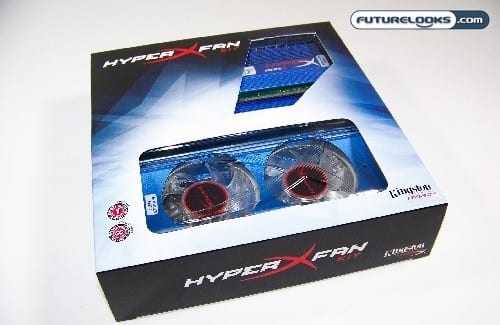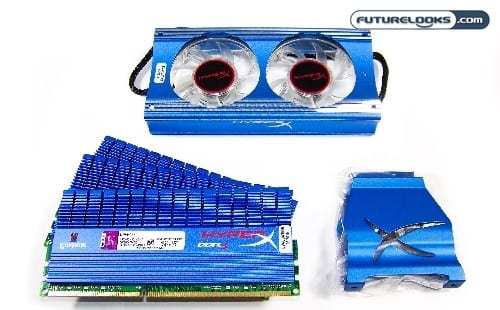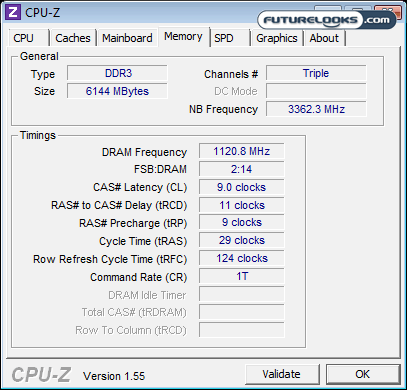
The Kingston HyperX 6GB 2250MHz DDR3 triple channel memory kit we’re looking at today is tuned for the most aggressive performance motherboards available. That would include any INTEL X58 motherboard capable of maintaining a 200MHz CPU bus clock without melting down and there are a lot of them out there. With an X58 board in hand and INTEL’s latest and greatest Core i7 980X Hexacore CPU, we give Kingston Technology’s top end memory kit a run for its money. Read on to find out how it did!
Features and Specifications
As you may or may not already be aware, 2250MHz is indeed one of the two pre-programmed XMP (Xtreme Memory Profile) profiles programmed into the memory kit’s SPD chips. XMP Profile 1 automatically configures the memory and CPU settings to use 2250MHz frequencies using timings at 9-10-9-27. XMP Profile 2 automatically configures to 2000MHz frequencies using 8-9-8-24 timings. Depending on your motherboard, it should set the memory kit to 1.65 volts during operations.
The memory kit also ships with a really cool looking aluminum, blue HyperX RAM fan. It sports two small blue LED cooling fans which make it look pretty cool when mounted. It fits perfectly to the tall blue T1 heat spreaders. If you’re picking up the 2133MHz, 2250MHz 6GB triple channel or 2400MHz 4GB dual channel memory kits, you’ll get this fan with it to ensure stable and cool performance from this top drawer memory kit.
This HyperX kit actually comes in both a triple channel kit with a 2x2GB configuration for around $149.99 US while the 3x2GB triple channel kit we’re testing today runs for about $312.99 US. The triple channel kit does seem more difficult to find at most stores likely owing to the fact that most enthusiasts like to take lower spec’d kits and overclock them successfully to this speed.
What’s in the Box?

The HyperX 6GB Triple Channel 2250 MHz kit is clearly not a cheap kit, but Kingston does its best to give you a great experience by clearly labeling the box and including documentation to ensure you get setup right and running at full speed. Kingston also creates value with this kit by including one of their HyperX Memory Fans in this kit. The kit does an effective job of cooling the memory kit to ensure top notch performance at such high frequencies and beyond. The fan fits easily over top of the tall blue T1 heat spreaders and when switched on they glow blue.
Test System Setup
In order to push the memory all the way to its rated speed and beyond, we’ve assembled a very capable INTEL X58 based system along with INTEL’s Core i7 980X CPU.
The system details include:
- Processor: Intel Core i7-980X Gulftown Hexacore Processor
- CPU Cooled By: Zalman CNPS10X Extreme CPU Cooler
- Motherboard: GIGABYTE GA-X58A-UD5 LGA1366 Motherboard
- Memory Kit One: Patriot Memory ViperII 6GB 2000MHz DDR3 Triple Channel Memory Kit (As Reviewed)
- Memory Kit Two: Kingston HyperX 6GB 2250 MHz DDR3 Triple Channel Memory Kit
- Graphics Card: ZOTAC Geforce GTX470 Video Card
- Storage/SSD: Kingston SSDNow V+ 128GB SSD
- Power Supply: Antec TPQ-1000 Watt
- Test Enclosure: DangerDen Torture Rack
Since we’re dealing with 6GB of memory, we’re using Windows 7 64-bit. Again, it’s very important that you consider the motherboard you’re currently using to run these kinds of high frequency memory kits. Not all motherboards are able to handle these high frequencies as this is technically overclocked and out of spec.
Installation Notes

You’re probably wondering is what ICs are underneath and how the memory performs. To answer the first question, these were Elpida stamped BG. Some other kits out there have been SE. Regardless of the ICs, these are obviously high quality binned modules, or else there is no way they could achieve 2250MHz. Besides, it’s not uncommon for chips to be changed out from batch to batch.
Also worth nothing is the fact that some motherboards have been known to configure completely different voltages for the same kit. Some motherboards can set the kit up with voltages ranging from 1.5V in the BIOS to 1.68V at the desktop. If your platform is acting up you should try manually setting the voltage to 1.65/1.66V in the BIOS to ensure success. There’s no point in bumping the voltage up till you start overclocking right?
